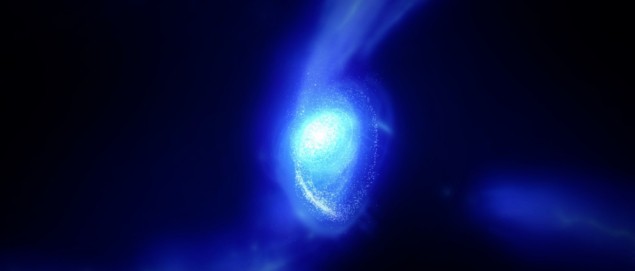
One of the most distant galaxies ever observed is very likely to be rotating, say astronomers. An international team led by Tsuyoshi Tokuoka of Waseda University, Japan, discovered the motion using observations from the Atacama Large Millimetre/submillimetre Array (ALMA) in Chile. The result offers crucial new insights into the evolution of newly formed galaxies and could provide useful guidance for upcoming observations with the James Webb Space Telescope (JWST).
When galaxies first began to form, the universe was in its “dark ages” – a period when virtually all matter was cool and transparent. As matter collapsed under gravity, galaxies formed, kicking off star formation in nascent galactic centres and triggering the so-called “epoch of reionization” that ended the dark ages. From there, star formation spread out into rotating galactic discs, where newer stars now reside.
Astronomers still have much to learn about the physics that governed these ancient galaxies. To shed new light on these questions, including the origins of the galactic rotation, Tokuoka and colleagues turned to observations from ALMA. This instrument has revolutionized the observation of distant, highly redshifted galaxies, owing to its impressive spatial and frequency resolutions.
In the latest study, the researchers used ALMA to study MACS1149-JD1: a gravitationally lensed galaxy that lies over 10 billion light-years away, making it one of the most distant objects ever confirmed. Through spectroscopy, astronomers have discovered that JD1 contains a population of stars roughly 300 million years old, placing its origins well inside the universe’s dark ages – just 270 million years after the Big Bang.
Different redshifts
The team examined the characteristic wavelengths emitted by doubly ionized oxygen (O III) in JD1. This gas is widely found in supernova remnants, making it a key component of material in the interstellar medium. Thanks to ALMA’s resolution, the team was able to identify variations in the redshift of O III emissions in different parts of the galaxy. This revealed a gradient in the velocity of material in JD1’s interstellar medium – with one side of the galaxy displaying a distinctly different redshift.
This observation satisfied nearly all criteria that must be met to confirm that a galaxy is rotating, making it the earliest example of a rotating disc ever discovered. Its rotational speed was also far slower than is found in other galaxies, including our own – suggesting that JD1’s rotational motion is still in its early stages.

Galaxy rotation study rules out modified gravity, or does it?
The result, which is described in The Astrophysical Journal Letters, means that astronomers have a record of galactic rotation speeds spanning over 95% of the universe’s total history, which members of the team say is an important step in understanding of how the physical characteristics of galaxies evolve. Tokuoka and colleagues now hope that many remaining questions will soon be answered with the help of the JWST, which should enable them to identify the ages of specific stellar populations inside the galaxy.



